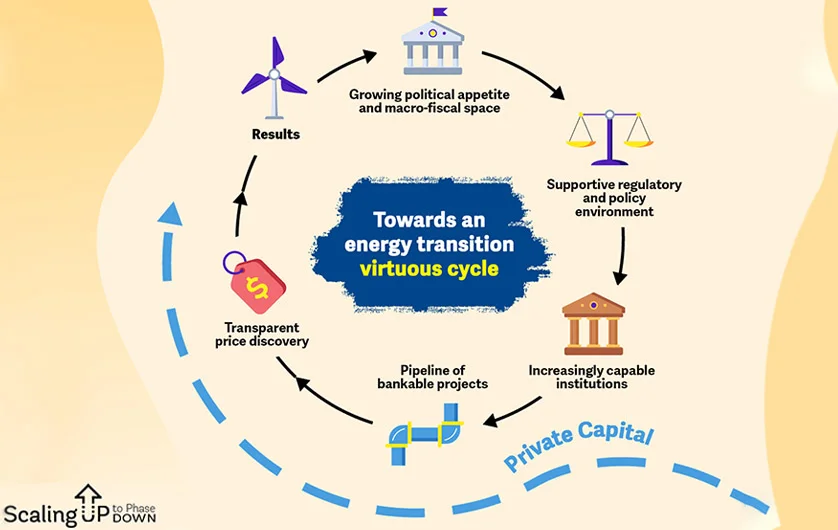Dependence on fossil fuels in many countries leads to a vicious cycle of increasing costs, higher energy prices for consumers, more pollution that impacts people’s health, and higher greenhouse gas emissions that endanger the planet. In contrast, transitioning to renewable energy can unlock a virtuous cycle that produces lower-cost electricity for consumers, builds resilience, and helps mitigate climate change
- Renewable energy can help countries reduce costs, build resilience and mitigate climate change.
- Many countries are trapped in a vicious cycle of fossil-fuel dependency.
- The World Bank has outlined steps approach to help countries break free from fossil fuel dependency.
- Steps include government commitment, supportive policies, institutional strengthening, project preparation, transparent procurement and affordable power
However, renewable energy projects do not materialize, and countries remain trapped in the vicious cycle. This happens despite the fact that many developing countries have some of the best solar and wind resources in the world. So how can we support governments to break free from fossil fuel dependency and catalyze the virtuous cycle for clean energy?
The World Bank has outlined an approach to propel a growing pipeline of clean energy projects in low- and middle-income countries. It consists of a virtuous cycle that can lead to more clean energy, attract private investors, and increase resilience. Each step reinforces the next, creating results that build momentum:
- Step 1 starts with the government asserting their commitment to long-term decarbonization and the energy transition by establishing targets and a strategy to advance clean energy.
- Step 2 establishes supportive policies and regulations that send a signal to markets and provide confidence about the government’s seriousness to change its energy mix. This phase includes policies that encourage private investment and operation, investment plans for network infrastructure where necessary, along with regulations that allow for streamlined procedures for licensing and approvals.
- Step 3 is the creation of institutions to strengthen ministries, regulators, sector planners, and energy utilities. These institutions should be assisted to make quality sector plans, set expectations for future power market developments, help investors navigate potential risks, and strengthen the transmission and distribution grids.
- Step 4 leverages institutions to create a pipeline of bankable clean energy projects. Some low- and middle-income countries have taken the lead in launching viable renewable energy projects for public facilities such as schools and hospitals, which create larger and therefore more attractive opportunities for investors. Larger-scale projects with well-selected locations and modest support for infrastructure have attracted the interest of major investors.
- Step 5 is to carry out transparent, competitive, and predictable procurement processes to attract investors and deliver affordable prices for consumers. A fair risk allocation between the private and public stakeholders, translated into clear contractual arrangements, attracts investment and drives down the costs of energy services.
- Step 6 yields results through affordable power on the grid, which strengthens national resolve, boosts consumer interest, raises ambitions, and attracts even more private sector involvement. The cycle gains momentum and obstacles in the first few cycles are resolved. Success breeds success.

Many developing countries face obstacles in obtaining the finance needed to scale up clean energy, which has slowed the momentum of the virtuous cycle. Governments need support to prepare transition plans, strengthen institutions that are the backbone of the power sector, and prepare early projects and mitigate risks that can keep costs out of reach. Affordable financing – below-market rate financing provided by major financial institutions such as development banks and multilateral funds – enables countries to overcome the toughest barriers to get their virtuous cycles started. Funding is especially needed at the start of the cycle to support policy and regulations, strengthen sector institutions, and populate the investment pipeline.
Even with sources of affordable finance to get started, developing countries must still make some difficult choices. They are under pressure to rapidly expand sources of electricity generation to serve the demands of growing populations and economies. With scarce capital to go around, many are currently forced to settle for fossil fuel-based electricity generation, with its much lower up-front capital costs and pay-as-you-go fuel expenses. Weak governance and poorly targeted subsidies can dig countries into an even deeper hole of fossil fuel dependence, despite the potential of clean energy to help them climb out. For instance, inefficient energy subsidies may be very politically challenging to remove, but by bringing in affordable clean energy, the need for fuel subsidies will gradually decline. Early help from the international community can improve the investment climate for clean energy, and get the virtuous cycle started.
We can do this. The energy transition virtuous cycle is already transforming the landscape in some countries. For example, India pledged in 2016 to generate approximately 40% of its electricity through non-fossil-fuel resources by 2030. The government has worked to improve its regulatory and fiscal environment, and instituted a Solar Parks policy to reduce barriers to private investment in large-scale solar. The competitively procured Rewa Solar Park has resulted in a record low tariff equivalent to 4.4 US cents per kilowatt hour, making it more attractive than coal-fired plants across the country. The $18 million dedicated to the project by the World Bank served to catalyze $575 million in private investment for the facility, a leverage of almost 32 times.
Once a strong track record is established, the virtuous cycle can propel lower- and middle-income countries into a successful transition to renewables. We must urgently accelerate the cycle so the world can thrive with safe, low-cost, and clean energy to meet growing demands.
Demetrios Papathanasiou Global Director for the World Bank’s Energy and Extractive Global Practice
Article was originally published by The World Bank
More Information visit www.worldbank.org and Sustainable Energy For All Series

